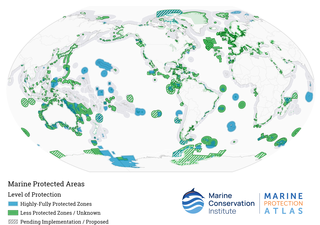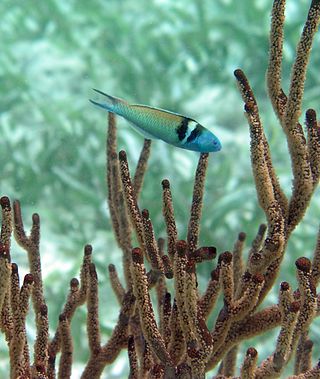Related Research Articles

Natural resources are resources that are drawn from nature and used with few modifications. This includes the sources of valued characteristics such as commercial and industrial use, aesthetic value, scientific interest, and cultural value. On Earth, it includes sunlight, atmosphere, water, land, all minerals along with all vegetation, and wildlife.

Protected areas or conservation areas are locations which receive protection because of their recognized natural or cultural values. Protected areas are those areas in which human presence or the exploitation of natural resources is limited.

The International Union for Conservation of Nature (IUCN) is an international organization working in the field of nature conservation and sustainable use of natural resources. Founded in 1948, IUCN has become the global authority on the status of the natural world and the measures needed to safeguard it. It is involved in data gathering and analysis, research, field projects, advocacy, and education. IUCN's mission is to "influence, encourage and assist societies throughout the world to conserve nature and to ensure that any use of natural resources is equitable and ecologically sustainable".

Man and the Biosphere Programme (MAB) is an intergovernmental scientific program, launched in 1971 by UNESCO, that aims to establish a scientific basis for the 'improvement of relationships' between people and their environments.

Habitat conservation is a management practice that seeks to conserve, protect and restore habitats and prevent species extinction, fragmentation or reduction in range. It is a priority of many groups that cannot be easily characterized in terms of any one ideology.

A marine protected area (MPA) is a protected area of the world's seas, oceans, estuaries or in the US, the Great Lakes. These marine areas can come in many forms ranging from wildlife refuges to research facilities. MPAs restrict human activity for a conservation purpose, typically to protect natural or cultural resources. Such marine resources are protected by local, state, territorial, native, regional, national, or international authorities and differ substantially among and between nations. This variation includes different limitations on development, fishing practices, fishing seasons and catch limits, moorings and bans on removing or disrupting marine life. MPAs can provide economic benefits by supporting the fishing industry through the revival of fish stocks, as well as job creation and other market benefits via ecotourism. The value of MPA to mobile species is unknown.

The Cerrado is a vast ecoregion of tropical savanna in eastern Brazil, being present in the states of Goiás, Mato Grosso do Sul, Mato Grosso, Tocantins, Maranhão, Piauí, Bahia, Minas Gerais, São Paulo, Paraná and the Federal District. The core areas of the Cerrado biome are the Brazilian highlands – the Planalto. The main habitat types of the Cerrado consist of forest savanna, wooded savanna, park savanna and gramineous-woody savanna. The Cerrado also includes savanna wetlands and gallery forests.
A nature park, or sometimes natural park, is a designation for a protected area by means of long-term land planning, sustainable resource management and limitation of agricultural and real estate developments. These valuable landscapes are preserved in their present ecological state and promoted for ecotourism purposes.

Landscape-scale conservation is a holistic approach to landscape management, aiming to reconcile the competing objectives of nature conservation and economic activities across a given landscape. Landscape-scale conservation may sometimes be attempted because of climate change. It can be seen as an alternative to site based conservation.

Natural resource management (NRM) is the management of natural resources such as land, water, soil, plants and animals, with a particular focus on how management affects the quality of life for both present and future generations (stewardship).

Since declaring independence in 1981, Belize has enacted many environmental protection laws aimed at the preservation of the country's natural and cultural heritage, as well as its wealth of natural resources. These acts have established a number of different types of protected areas, with each category having its own set of regulations dictating public access, resource extraction, land use and ownership.

Conservation photography is the active use of the photographic process and its products, within the parameters of photojournalism, to advocate for conservation outcomes.
The Protection of the Arctic Marine Environment Working Group (PAME) is one of six working groups encompassed by the Arctic Council. Founded as part of the 1991 Arctic Environmental Protection Strategy, it assimilated into the structure of the Council following the signing of the 1996 Ottawa Declaration by the eight Arctic states. The Working Group claims to operate across the domains of Arctic shipping, maritime pollution, marine protected areas, ecosystem approaches to management, resource exploitation and development, and associations with the marine environment. Where necessary, it is tasked with producing guidelines and recommendations for policy improvement, with projects approved every two years by the council.
Indigenous and community conserved areas (ICCAs), or Indigenous peoples’ and community conserved territories and areas, are spaces de facto governed by Indigenous peoples or local communities with evidently positive outcomes for the conservation of biological and cultural diversity. In ICCAs, the continuation, revival, or modification of traditional practices and/or new initiatives succeed in protecting and restoring natural resources and cultural values in the face of new threats or opportunities. Some ICCAs are situated in remote ecosystems that have had minimum human influence, while others encompass areas of various regulations and magnitudes within regions strongly affected or modified by human occupation. ICCAs may or may not fit the IUCN definition of “protected area” but, when they do, they can fall into any IUCN protected area categories.

IUCN protected area categories, or IUCN protected area management categories, are categories used to classify protected areas in a system developed by the International Union for Conservation of Nature (IUCN).

A strict nature reserve or wilderness area is the highest category of protected area recognised by the World Commission on Protected Areas (WCPA), a body which is part of the International Union for Conservation of Nature (IUCN). These category I areas are the most stringently protected natural landscapes.
NABQ Protected Area (NPA) is a 600 km2 (230 sq mi) protected area located in the Egypt, South Sinai Governorate. It was established by the Prime Ministerial Decree no.1511/1992 and was extended by Decree 33/1996 where Dahab marine section was added to the protected area as a Dahab Environmentally Managed Area DEMA and finally having NABQ Managed Resource Protected Area which is known shortly as (NMRPA).

Lower South East Marine Park is a marine protected area in the Australian state of South Australia located in the state's coastal waters in the state’s south-east adjoining the border with the state of Victoria.

The National System of Nature Conservation Units, abbreviated SNUC, is a set of regulations and official procedures that enable the federal, state and municipal government departments, as well as private initiative, to create, implement and manage Conservation Units (UC) in order to organize nature preservation in Brazil.
References
- ↑ Category VI - Protected Area with sustainable use of natural resources Archived 2011-06-29 at the Wayback Machine at www.iucn.org. Accessed on 11 Jun 2011.